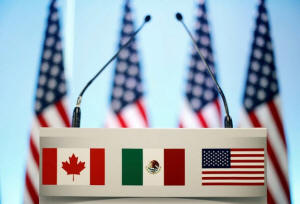|
Delays and 'poison pills': team Trump
runs out of road in NAFTA talks
 Send a link to a friend
Send a link to a friend
 [May 29, 2018]
By David Lawder and David Ljunggren [May 29, 2018]
By David Lawder and David Ljunggren
WASHINGTON (Reuters) - President Donald
Trump is running out of time to deliver a revamp of the North American
Free Trade Agreement (NAFTA) he promised for this year and people
involved in the talks say the crunch is largely of his administration's
own making.
Negotiators, industry lobbyists, trade experts and lawmakers briefed on
the talks described how precious months passed before the U.S team
presented its proposals and how the talks stalled because the demands
far exceeded what Canada and Mexico had expected and Washington signaled
no readiness to compromise.
In the end, an unusually tight timetable allowed little space to bridge
differences on the core issues, such as U.S. and regional content
requirements for the auto industry.
Talks started last August with a goal to conclude in just four months,
but as a May 17 notification deadline to allow the current
Republican-led U.S. Congress to approve a new agreement before year end
passed, U.S. Trade Representative Robert Lighthizer warned a deal was
"nowhere near close."
TIME PRESSURE SHIFTS
Up until a few weeks ago, Lighthizer thought Mexico faced the biggest
time pressure to wrap up the talks before its July 1 presidential
elections, a Mexican source close to the talks told Reuters.
In early May, however, Mexican Economy Minister Ildefonso Guajardo told
Lighthizer in Washington that he would be able to negotiate a NAFTA
agreement up until the Dec. 1 transition to a new government - even if
an opposition candidate won.
Suddenly, it was the United States running against the looming
congressional deadline, the Mexican source said.
The Trump administration's negotiating goals submitted to Congress in
July 2017 talked of shrinking trade deficits with Mexico and Canada and
boosting U.S. auto production. (Graphic:http://tmsnrt.rs/2oYClp2)

In contrast, the U.S. neighbors saw the talks more as a "modernization"
exercise, proposing, for example, chapters on digital trade that did not
exist when NAFTA took effect in 1994.
Broadly, both were fine with the status quo, so when it took Washington
two months to present specific demands the delay played into their
hands.
"How can you launch talks to update a treaty and then make everyone wait
months before you explain what you want," asked one Canadian official
briefed on the talks.
Lighthizer's office said he was clear all along about aiming to
"rebalance" NAFTA trade in U.S. favor.
"The United States has been very clear and specific from the start about
what we hope to see in a new NAFTA and has worked at an unprecedented
pace to negotiate a better deal for America," the office's spokesman
said.
When Lighthizer's team presented the demands in October, Canadian and
Mexican officials said they amounted to surrendering decades of trade
benefits, which they could not accept.
U.S. business groups labeled those demands "poison pills" that
threatened to derail the talks and prompt Trump to quit the pact. The
key ones were: a steep increase in regional automotive content
requirements, a demand for half the value of North American vehicles to
originate in the United States and a requirement to renegotiate the pact
every five years.

All remain unresolved, despite nearly eight weeks of marathon
negotiations in Washington in April and May, focused mainly on autos.
[to top of second column]
|

The flags of Canada, Mexico and the U.S. are seen on a lectern
before a joint news conference on the closing of the seventh round
of NAFTA talks in Mexico City, Mexico, March 5, 2018. REUTERS/Edgard
Garrido/File Photo

Canada and Mexico had their role in running down the clock. It has taken
Ottawa and Mexico three months to produce counterproposals, drawing
criticism from Lighthizer they were failing to “engage.”
Canadian and Mexican negotiators argued they needed time to understand
the logic of U.S. demands because they came without customary backup
evidence and analysis. U.S. negotiators said it was the consequence of
the extremely tight timetable.
But U.S. chief negotiator John Melle privately complained to U.S.
colleagues that Ottawa was deliberately wasting time on less essential
matters, such as proposed new chapters on women's and indigenous
people's rights, a U.S. source close to the talks said. Canadian
officials deny trying to drag out negotiations.
Speaking at a business event early this year, Canada's veteran chief
negotiator, Steve Verheul, described the talks as the "most unusual
negotiation" he had ever been involved in, because of Washington's
winner-takes-all approach.
"They are looking to strengthen the U.S. and by doing that weaken Canada
and Mexico."
WHICH LIGHTHIZER?
Trump's threats to quit NAFTA and Washington's uncompromising stance
made some involved in the talks wonder whether its goal was to blow up
the pact or improve it.
"My boss thinks 40 percent of Lighthizer wants a deal, 60 percent
doesn't, and you see both Lighthizers, sometimes in the same
conversation," one NAFTA diplomat told Reuters.
Lighthizer frequently told reporters and lawmakers that he was
negotiating for “an audience of one,” and it was ultimately Trump's call
whether to accept or reject a deal.
Talks seemed to gain some momentum in early April, when U.S. negotiators
toned down their automotive demands - cutting the proposed regional
content threshold by 10 percentage points to 75 percent, but with a $16
minimum wage component for 40 percent of autos. Mexico responded with 70
percent and 20 percent, respectively, though Guajardo on Friday still
put chances of a deal before July 1 at about 40 percent.
However, with Washington waging trade battles on other fronts it has
been hard to sustain that momentum.
For example, when the United States threatened to hit Chinese imports
with tariffs because of intellectual property concerns and talks reached
a critical phase in late April, a trade mission to Beijing took
Lighthizer away from NAFTA for a week.

And last week, his office launched a national security investigation
that could lead to tariffs on vehicle and auto parts imports from North
America, Europe and Asia. Canadian Prime Minister Justin Trudeau told
Reuters on Thursday the move was intended to pressure Canada and Mexico
in the NAFTA talks.
Whether they will yield to that pressure is another matter and in the
meantime the probe could end tying up Lighthizer's stretched resources.
Even with a deal on autos, it could take time to work out other issues,
such as intellectual property safeguards for drugmakers, said former
U.S. trade negotiator Wendy Cutler.
"Sometimes there's just not enough time to come up with creative
solutions."
(Additional reporting by Anthony Esposito and Dave Graham; Writing by
David Lawder; Editing by David Chance and Tomasz Janowski)
[© 2018 Thomson Reuters. All rights
reserved.]
Copyright 2018 Reuters. All rights reserved. This material may not be published,
broadcast, rewritten or redistributed.
Thompson Reuters is solely responsible for this content. |